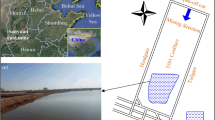Abstract
Mechanical properties of Neogene sedimentary soft rocks and their discontinuities are deteriorated by environmental changes, such as wetting and stress release. In addition, the reliable estimation of shear strength of weakness planes in these rocks is a common problem. This paper aims to characterize the engineering properties of weak, stratified, clay-bearing coal measures encountered in surface coal mining in southwest Turkey with special reference to the shear strength of their discontinuities and weak zones which are of particular significance in determining slope stability. The results obtained from a series of laboratory shear tests carried out on specially prepared bulk samples containing natural discontinuities and weak zones were compared with values, which resulted from tests on similar weakness planes in another pit and back-analyses of instabilities experienced in two mines, for further design considerations.
Résumé
Les propriétés de roches sédimentaires tendres d'âge Neogène et leurs discontinuités sont modifiées par des changements tels que l'humidité ou la détente des contraintes. D'autre part, une bonne estimation de la résistance au cisaillement des plans de faiblesse est un problème important. Cet article a pour but de caractériser les propriétés des niveaux charbonneux tendres, stratifiés et contenant de l'argile, dans une exploitation de charbon à ciel ouvert du sud-ouest de la Turquie, en s'intéressant particulièrement à la résistance au cisaillement des discontinuités et des zones faibles qui ont une signification particulière dans la détermination de la stabilité des pentes. Les résultats obtenus après une série d'essais de cisaillement sur des échantillons présentant des discontinuités naturelles et des zones de faiblesse, sont confrontés aux valeurs obtenues sur des plans de faiblesses semblables dans une autre mine et aux analyses d'instabilités reconnues dans deux autres mines.
Similar content being viewed by others
References
APAYDIN N. and ULUSAY R., 1990: Geotechnical investigation report on TKI-GELI Milas-Sekköy Open Pit. Unpublished MTA Report No.8955, MTA Library, Ankara, 114 p.
CAVOUNIDIS S. and SOTIROPOULOS E., 1979: Strain softening marly rock. Fourth Int. Cong. on Rock Mechanics, Montreux, Switzerland, vol. 2: 63–66.
DEERE D.U. and MILLER R.P., 1966: Engineering classification and index properties for intact rock. Technical Report No.AFWL-TR-65-116, Air Force Weapons Lab., Kirtland Air Force Base, 308 pp.
FAZIO A.L. and TOMMASI P., 1990: Sheared bedding joints in rock engineering: two case histories in Italy. Proc Int. Symp. on Rock Joints, Leon, Norway: 83–90.
FELL R., SULLIVAN T.D. and MACGREGOR J.P., 1988: The influence of bedding plane shears on slope instability in sedimentary rocks. Proc. Fifth Int. Symp. on Landslides, Lousanne, Switzerland, vol. 1: 129–134.
FERGUSON H.F. and HAMEL J.V., 1981: Valley stress relief in flatlying sedimentary rocks. Proc. Int. Symp. on Weak Rock, Tokyo, vol. 2: 1235–1241.
FRANKLIN J.A. and CANDRA R., 1972: The slake durability test. Int. Jour. Rock Mech. Min. Sci. & Geomech. Abst., vol. 9: 325–341.
HAWKINS A.B. and PRIVETT K.D., 1985: Measurements and use of shear strength of cohesive soils. Ground Engineering, vol. 18: 22–29.
HENCHER S.R. and RICHARDS L.R., 1989: Laboratory direct shear testing of rock discontinuities. Ground Engineering, vol. 22: 24–31.
ISRM (International Society for Rock Mechanics), 1981: Rock characterization, testing and monitoring-ISRM suggested methods. Pergamon Press, Oxford, 211 p.
MIMURO T., YAMAUCHI M., WATANABE K. and DENDA A., 1991: Deterioration of mechanical properties of Neogene sedimentary soft rocks. Seventh Int. Cong. on Rock Mech., Aachen, W. Germany, vol. 1: 299–302.
RICHARDS B.G., COULTHARD M.A. and TOH C.T., 1981: Analysis of slope stability at Gonyella Mine. Canadian Geotechnical Journal, 18: 179–194.
ULUSAY R., 1991: Geotechnical evaluations and deterministic design considerations for pitwall slopes at Eskihisar (Yatagan-Mugra) strip coal mine. Unpublished Ph.D. Thesis, Department of Geological Engineering, Middle East Technical University, Ankara, Turkey, 340 p.
ULUSAY R. and DOYURAN V., 1993: Characteristics and geotechnical considerations of translational rock slides in a strip coal mine, southwestern Turkey. Proc. of the Int. Symp. on Assessment and Prevention of Failure Phenomena in Rock Engineering, April 1993, Istanbul, Turkey, A.A. Balkema, 529–535.
Author information
Authors and Affiliations
Rights and permissions
About this article
Cite this article
Ulusay, R., Yoleri, M.F. Shear strength characteristics of discontinuities in weak, stratified, clay-bearing coal measures encountered in Turkish surface coal mining. Bulletin of the International Association of Engineering Geology 48, 109–117 (1993). https://doi.org/10.1007/BF02594983
Published:
Issue Date:
DOI: https://doi.org/10.1007/BF02594983




